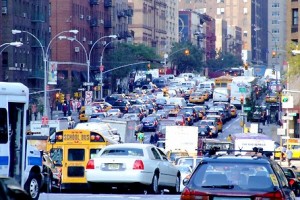Pay more, drive less. That seems to be the formula more and more American motorists are following these days.
Despite a bit of a reprieve as fuel prices slip slightly, it appears U.S. motorists are steadily trimming back on travel, whether for vacations or simply when running errands, according to the latest data from the Federal Highway Administration.
For the first half of this year, Americans drove 1.453 trillion miles, a 1.1% decline compared to the January – June period the year before. It was also a 44 billion mile decline from the first half of 2009, when Americans set a motoring record of 1.497 trillion miles.
But lower fuel prices could encourage more drivers to get back behind the wheel – the AAA projecting that the nation’s holiday travelers drive more and fly less during the long Labor Day weekend.
June brought the fourth straight month of declining traffic, according to the Highway Administration. Overall travel was down 1.4%, with the biggest decline in South-Gulf region.
The decline in driving is being felt at the refinery level. The American Petroleum Institute reports that U.S. refineries produced 2.3% less gasoline in July compared to the year prior, the first year-over-year decline of 2011.
“Consumers aren’t spending, and jobless claims have increased, so it isn’t surprising gasoline demand was down and overall demand slipped a bit,” said API’s Chief Economist John Felmy.
But analysts also suggest that even those American motorists with secure jobs are simply being more careful about when and how they drive, eliminating unnecessary trips and stacking chores to get more done in a single trip.
Declining demand for fuel may also reflect a slow but steady shift in the sort of vehicles Americans are buying, data service Edmunds reporting a 3.6% increase in fuel-efficient small car sales for the first half of the year, while sales of utes and crossovers has dipped.
But historical data show that such shifts can be short-lived. In 2008, demand for SUVs began to recover even before prices hit a record $4.14 per gallon of regular unleaded in July.
Could the forecast by AAA be an indication that the recent dip in pump prices will have a reverse impact on motorist behavior? Petroleum has plunged from a recent high of over $110 a barrel to barely $85 in Friday morning trading. For motorists, that has translated into a 10% drop in gas prices since this year’s May peak. But fuel is still running at a national average $3.57 a gallon, or $0.86 more than a year ago.
Coincidentally or not, a new AAA report forecasts more travelers will be on the road over the upcoming holiday.
A total of 31.5 million Americans will travel at least 50 miles during the extended break, according to the AAA, which would be a 2.4% decline from Labor Day 2010. But the dip is the result of fewer folks taking to the air. Of those traveling, 87% said they will go by car this time, up from 84% last year.
Even so, travel plans appear to be trimmed back. The average road trip will be 608 miles, motorists told the travel and insurance company, down from 635 over Labor Day weekend 2010. Fuel and transportation costs are expected to make up the single biggest portion of the average $702 cost, consuming 27% of the average holiday travel budget.

